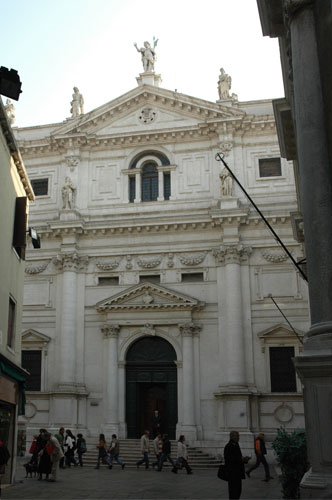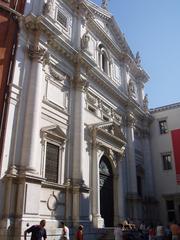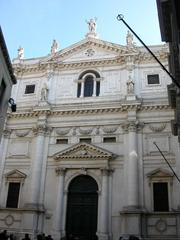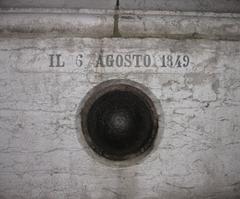
Visiting San Salvador, Venice, Italy: Complete Guide to Tickets, Hours, and Tips
Date: 14/06/2025
Introduction
Nestled in the heart of Venice, the Church of San Salvador (Chiesa di San Salvatore) stands as a testament to the city’s rich historical, architectural, and artistic legacy. Tracing its origins back to the 7th century, San Salvador has evolved alongside Venice, embracing Renaissance grandeur and Baroque embellishments. The church is celebrated not only as a spiritual landmark but also as a repository of Renaissance art, notably housing masterpieces by Titian such as the “Annunciation” and “Transfiguration.” Its innovative architectural design, including three domes aligned over the nave and a striking Baroque façade by Giuseppe Sardi, exemplifies Venetian artistic ingenuity (venezia-tourism.com; Wikipedia).
Strategically located along the Mercerie shopping street near the iconic Rialto Bridge, San Salvador invites visitors to immerse themselves in a unique intersection of art, history, and living tradition. The church also houses important funerary monuments, such as the tomb of Doge Francesco Venier and the remains of Caterina Cornaro, former Queen of Cyprus, underscoring its central role in Venetian civic and religious life (Zainoo; InVeniceToday).
This detailed guide provides essential information—from historical context and architectural highlights to visiting hours, ticketing, accessibility, and insider tips—ensuring you make the most of your visit to this hidden gem of Venice.
Table of Contents
- Introduction
- Historical Overview
- Architectural Highlights
- Visiting San Salvador: Practical Information
- Conservation and Restoration
- Visitor Facilities and Tips
- Nearby Attractions
- Visitor Etiquette and Local Customs
- Frequently Asked Questions (FAQ)
- Visuals and Media Suggestions
- Conclusion
- Call to Action
Historical Overview
Early Origins and Medieval Foundations
San Salvador’s roots stretch back to the 7th century, with archaeological and documentary evidence suggesting a place of Christian worship existed here as early as the 600s CE (venezia-tourism.com). By the 12th century, the church was rebuilt in the Romanesque style and gained prominence when Pope Alexander III consecrated it in 1177, shortly after his reconciliation with Emperor Frederick Barbarossa—a testament to its spiritual and political significance (Wikipedia).
Renaissance Rebuilding and Architectural Evolution
The current structure embodies Venetian Renaissance ideals. Reconstruction began in 1506 under prior Antonio Contarini, with architects such as Giorgio Spavento, Tullio Lombardo, and Vincenzo Scamozzi contributing to its design (Your Venice). The innovative plan features three Greek crosses aligned end-to-end, each crowned with a dome, flooding the interior with daylight. The Baroque façade, designed by Giuseppe Sardi, was added in 1663. The separate bell tower, begun in the 14th century, was completed in the 19th century, reflecting layers of Venetian history (Your Venice).
Artistic Heritage and Interior Treasures
San Salvador is renowned for its Renaissance masterpieces. Titian’s “Annunciation” and “Transfiguration” grace the high altar and side chapels (Zainoo). Works by Paris Bordone and others enrich the church. Funerary monuments, including the tomb of Doge Francesco Venier and the remains of Caterina Cornaro, reflect the church’s role in Venetian society (Zainoo).
Religious and Cultural Significance
An active parish church, San Salvador is central to the Vicariate of San Marco-Castello, hosting regular masses and events (Wikipedia). The former monastery, attributed to Sansovino, was secularized under Napoleon and is now a business premises, though the cloisters are preserved (churchesofvenice.com). The church continues to foster community through exhibitions, concerts, and outreach (venezia-tourism.com).
Notable Historical Events
The façade features a cannonball from the 1849 Austrian siege, a relic of Venice’s political struggles (Wikipedia). The foundation stone of the Renaissance church was laid on March 25, 1507, a date rich in Venetian legend and religious symbolism (churchesofvenice.com).
Architectural Context within Venice
San Salvador’s Renaissance design contrasts with the Byzantine St. Mark’s and the Gothic Doge’s Palace, embodying a distinct Venetian style (parametric-architecture.com). John Ruskin lauded its interior among the city’s finest Renaissance works (churchesofvenice.com).
Architectural Highlights
Exterior and Façade
The Baroque façade, completed by Giuseppe Sardi in 1663, is distinguished by Corinthian pilasters, balanced portals, and sculptural works by Bernardo Falcone (InVeniceToday). The adjacent Scuola di San Salvador echoes these elements, creating a cohesive architectural ensemble.
Interior Layout and Spatial Organization
The interior follows a basilica plan with three naves, divided by elegant Corinthian columns, and features three domes aligned along the central nave. This arrangement allows sunlight to illuminate artworks and decorative elements (InVeniceToday).
Artistic Masterpieces and Decorative Elements
Highlights include Titian’s “Annunciation” and the “Cena di Emmaus,” attributed to the Bellini school. Sculptors like Alessandro Vittoria, Jacopo Sansovino, and Girolamo Campagna contributed significant works, such as Sansovino’s monument to Doge Francesco Venier. The high altar boasts a 14th-century gilded silver altarpiece, typically concealed behind Titian’s “Transfiguration” (InVeniceToday).
Structural Innovations
The three-dome design, supported by pendentives and drums, demonstrates advanced Renaissance engineering, especially given Venice’s challenging, waterlogged foundations.
Funerary Monuments and Relics
San Salvador is a site of memory, housing the tomb of Doge Francesco Venier and the urn of Saint Theodore, Venice’s first patron (InVeniceToday).
Atmosphere and Acoustics
Natural light from the domes enhances the church’s luminous character. The domes also improve acoustics, making San Salvador a favored venue for sacred music and choral performances.
Urban Relationship
Located at Campo San Salvador, near the Rialto Bridge, the church exemplifies the Venetian tradition of integrating religious, commercial, and civic spaces (ArchDaily).
Visiting San Salvador: Practical Information
Location and Getting There
- Address: Campo San Salvador, S. Marco, 4835, 30124 Venezia, Italy (Meeting Venice).
- By Vaporetto: Nearest stop is Rialto (lines 1 & 2), 3–5 minutes’ walk along Mercerie.
- On Foot: 3 minutes from Rialto Bridge, 6–8 minutes from Piazza San Marco.
Visiting Hours
- Monday to Saturday: 9:00 am – 12:00 pm, 4:00 pm – 6:30 pm
- Closed Sundays for tourist visits; open for worship (Meeting Venice).
Tickets and Admission
- Admission: Free for individual visitors.
- Guided Tours: Available by prior booking; fees may apply depending on group size and language.
Guided Tours and Special Events
- Book tours via phone (+39 041 523 6717), email ([email protected]), or through Venice tourism portals (Meeting Venice).
- The church hosts occasional concerts and exhibitions. Photography without flash is allowed; tripods and professional gear require permission.
Accessibility
- Entrance is at street level; some limitations due to Venice’s infrastructure.
- No elevators or accessible restrooms; contact the church in advance for specific needs.
Visitor Facilities and Practical Tips
- Dress Code: Shoulders and knees should be covered.
- Restrooms: Not available inside; nearest facilities are at Rialto Bridge and Piazza San Marco.
- Seating: Benches available inside.
- Nearby Amenities: Numerous shops and cafés in the vicinity.
Travel Tips
- Best Time to Visit: Weekdays, early morning or late afternoon, especially in spring or autumn, are quieter.
- Photography: Permitted without flash; be respectful during Mass.
- Safety: Beware of pickpockets in crowded areas.
Conservation and Restoration
Ongoing efforts preserve San Salvador’s architecture and artworks, focusing on structural stability, artwork cleaning, and material conservation (InVeniceToday).
Nearby Attractions
- Rialto Bridge (3-minute walk)
- Piazza San Marco (6–8-minute walk)
- Mercerie shopping street
- Other historic churches: Santa Maria Formosa, San Bartolomeo, San Giovanni Crisostomo (Earth Trekkers)
Visitor Etiquette and Local Customs
- Maintain silence.
- No eating or drinking inside.
- Donations are appreciated.
Frequently Asked Questions (FAQ)
Q: Is there an entrance fee?
A: No; entry is free for individual visitors.
Q: What are the church’s visiting hours?
A: Monday–Saturday, 9:00 am–12:00 pm and 4:00 pm–6:30 pm; closed to tourists on Sundays.
Q: Are guided tours available?
A: Yes, by prior booking via phone or email.
Q: Is the church wheelchair accessible?
A: Accessibility is limited; contact the church ahead for arrangements.
Q: Can I take photographs inside?
A: Yes, without flash; professional gear requires permission.
Q: When is the best time to visit?
A: Early mornings or late afternoons on weekdays, especially in spring or autumn.
Visuals and Media Suggestions
- Include images of San Salvador’s façade, Titian’s “Annunciation,” the high altar, and major monuments with descriptive alt text such as “San Salvador Venice façade with Baroque elements” and “Titian’s Annunciation painting inside San Salvador.”
- Add an interactive map highlighting San Salvador’s location and nearby attractions.
- Virtual tours and online galleries are available via the official website and major tourism portals.
Conclusion
The Church of San Salvador is a treasure trove of Renaissance art, innovative architecture, and Venetian history. Its central location, accessibility, and ongoing cultural vitality make it a must-visit for travelers, art lovers, and anyone seeking to experience the soul of Venice.
Call to Action
Download the Audiala app for detailed audio guides, interactive maps, and the latest updates on San Salvador and other Venice historical sites. Follow us on social media and explore related posts to enrich your journey through Venice.















































































































